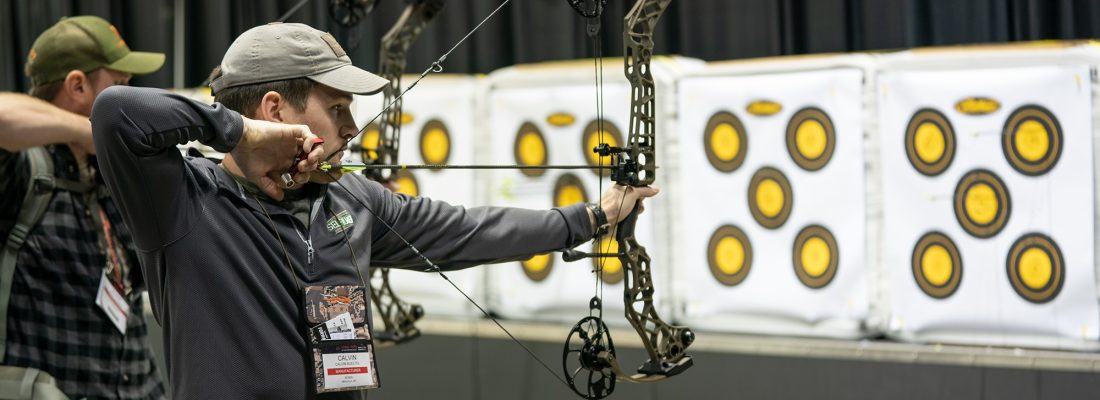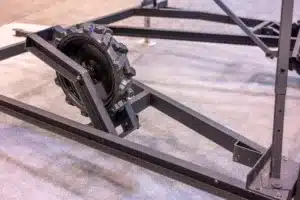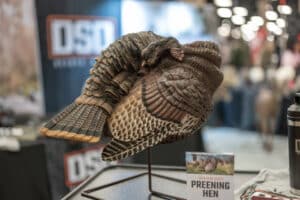No products in the cart.

365 Archery 3D Archery Targets
When folks enter a new industry, or even a new subsection of their industry, they usually dip their toe in by offering one or two

Blog / Field Updates / ATA Show / Bow Shootoff – 2020 ATA Show

I was able to do something I’ve always wanted to do as the 2020 ATA Show wound to down on Saturday; A bow shoot off. If you are like me, you’ve probably pair the list of bows down to a couple in your price range, and shoot only those or ones on the sale rack. While I’ve shot a couple different manufacturer’s bows, I’ve never taken the time to shoot some of the other major, and not-so-major, manufacturer’s bows. Especially not in a side-by-side comparison. This bow shoot off did not get to all of them, but I got to several.
Disclaimer: the following text is my opinion and my opinion only. Your thoughts and conclusions will vary. I really recommend you get out and do your own side by side shooting and pick the bow that best fits you!
The bow shoot off started with one of my usual suspects: Mathews’ flagship bow. While not the first compound I ever shot, a Mathews was the first bow I had ever spent my own hard-earned cash to purchase. They had a VXR 31.5 at 29″ draw and 70 lbs available. First impression: This riser is REALLY long.
Draw cycle was smooth, string angle was nice, and it was dead in my hand after the shot. For a decently fast bow I was surprised with the shot. Sweet, yet quiet “thunk” to it upon release. Granted, it was the first bow I had shot at the show, but I loved it. Bow felt a little heavy, but wasn’t terrible. With an MSRP of $1199, it was a little high on the price list.
Mathews VXR 31.5 Specs:
Next up I headed to the Hoyt booth. Not only do I currently shoot a Hoyt, but I’ve had a couple different models in the past and I loved all of them. I decided to shoot both their aluminum and carbon flagship bows, the Axius Ultra and RX-4 Ultra. While not my hunting weight, they had a 29″ draw in 60 lbs for both so I went with it. First one up: the RX-4 Ultra.
First impression: This bow is downright sexy. Having previously owned a carbon bow I loved the feel and warmth to the touch that carbon provides over an aluminum bow. However, for being a lightweight carbon bow, this bow was slightly heavy at 4.1lbs. As for the shot, the RX-4 had an extremely smooth draw, and solid back-wall. However, I did notice a little jumpiness in the hand upon the shot. I realize it’s a bare bow, but I did not see this same jumpiness in some of the other bare bows I shot.
Hoyt Carbon RX-4 Ultra Specs:
First impression: Looks like your traditional aluminum compound from Hoyt. Don’t get me wrong, Hoyt makes some sexy looking bows, but it didn’t speak to me like the RX-4 did. It had the same smooth draw and solid back-wall I loved with the RX-4. However, the shot feel was noticeably more pleasant than the RX-4. Maybe it was the half-pound extra it was carrying. Other than the weight, specs were the same as the RX-4. They also both offered the integrated QAD mount like Mathew’s line did last year. Either way, with an MSRP of $1249, it is still on the pricy side.
Hoyt Axius Ultra Specs:
To be honest, this is the first time I’ve ever shot a Martin bow. First impression on the ADIX30: meh. Not great, not bad. Liked the fact that you “could” change the draw length with simple mods without a bow press. Luckily they had my size in 29″, but I had to make due with a 60lb draw. However, even at 60lbs, the draw felt very rough. The shot was a little jarring too, even with the stabilizer on. At 341 FPS it wasn’t a slouch in the speed department. After the first three bow’s giving me sticker shock, I did like the price. $997 MSRP.
Martin ADIX30 Specs:
Xpedition was also a first to me. First impression on the Denali DLX: This looked like an older bow. Granted, it did have neat little bridge areas in the riser. However, what really stood out to me was the paint job. While this was painted an almost candy-green color, it wasn’t the color that bugged me. The paint was noticeably more thin around every edge. One may have been able to spray paint it with better results. Aside from the paint job, this bow shot significantly better than the Martin. Really smooth draw. With the option of both limb stops and cable stops, the back wall was solid as a rock. The shot did feel better than the Martin, but not near as good as the earlier bows I had shot. What surprised me the most about this bow was the high price: $1199.
Xpedition Archery Denali DLX Specs:
First impression: It was difficult to shake the “toy bow” image in my head. When I saw the Disrupter 24 all I could picture was the Slingbow. That said, it didn’t feel “cheap” by any means. At a 75lb draw, it was by far the heaviest draw weight I encountered at the show. However, the draw cycle felt surprisingly smooth. The shot didn’t feel, or sound smooth though. There was a notable report, almost like a subsonic .22LR shot. The shot was loud enough that I asked the rep if it was normal. Although it sounded like one, at 330fps it was not what most would consider a fast bow. Spec wise, for an approximately 24 5/8″ ATA and for something that looks this skeletonized I did not expect it to weigh four pounds. However, I did like that the brace height was adjustable from 5.5″-7″. The small size was also a neat feature… would make it quite maneuverable in a blind or tight treestand. Most of all, I liked the $749 price point. This would be the least expensive bow that I shot all day.
Gearhead Disrupter 24 Specs:
Determined to show me a more quiet bow, the rep handed me their Flagship B30. First impression: Despite the still odd looks, this bow handled much more like a traditional bow. However, even though it was the same draw weight as the Disrupter, the draw cycle actually felt harsh. After the draw, the back wall was quite nice. At 350 FPS, I expected a slightly louder shot but was decently surprised. I’ll admit, I was mainly comparing it to the Disrupter which set the bar pretty low. The center shot for both bows made it a little awkward loading the follow-up shot, but I’m sure it’s just my old habits. With specs that resemble most other bows on the market (350 fps, ATA 30.5″, and 4.5 lbs), the biggest selling point to me would have been the adjustable brace height from 5.5″-7″ like the disrupter. At $949 MSRP it was more reasonable than most of the others I shot, but I still don’t think I’d sink a grand into this bow.
Gearhead B30 Specs:
PSE is a company I had always heard of but never took the time to try. Since they had a carbon bow, and I’d only shot one other that day, I decided to make a stop. First up was a version of their Carbon Bow in 60lb – the Carbon Air Stealth Mach1. Sweet name.
First impression: This thing is light! A more simplistic riser than the Hoyt RX-4 Ultra, I thought I wouldn’t like it as much. Once I got it in hand I grew to appreciate it. This had a buttery smooth draw cycle, but the slightly spongy back wall left some to be desired. After the shot, the bow did exactly what I would expect from a 3.5lb bow: It damn-near jumped out of my hand. Aside from the weight, the only other spec that jumped out to me was the price. At $1600, it’s second only to the Hoyt RX-4 Ultra. However, I felt like the other specs didn’t justify the price.
PSE Carbon Air Stealth Mach 1 Specs:
To compare with a more traditional bow I shot another of their flagships: the EVO NXT 33. First impression: This looked and felt like a typical, higher-end aluminum bow. They only had this one at 50lb, but the draw cycle was noticeably smooth even discounting for the lighter weight. The EVO NXT 33 had the same back wall as the Carbon Air Stealth Mach 1, but the shot felt significantly better. This bow didn’t budge. Considered a slow bow by todays standards. The 7″ brace height would be a little more forgiving for a shooter like me who’s form is not perfect. I really liked the price compared to some of the others at $1100.
PSE EVO NXT 33 Specs:
My last two bows have been Hoyts. Before the show, I probably would have leaned towards the Hoyt Carbon RX-4 as I’m a sucker for looks. However, after shooting them, here are my thoughts:
For someone looking to get the best bow they can get with the least amount of money, I’d have to lean towards PSE’s EVO33 NXT. To be fair, I’ve never been a PSE guy. That said, I’d personally consider buying this bow. While it’s not the fastest in the bunch, the longer brace height should make up for my lack of prowess. A wise man once told me “it’s better to hit slow than to miss fast.”
While there is not a huge difference in price, the bow I thought shot the best was Mathews VXR 31.5. If you can scrape up the extra $100, and your form is better than mine, it’s worth the extra money. It is a little short with the 6″ brace height, but not unwieldy.
Right behind the VXR 31.5, I’d put Hoyt’s Axius Ultra. At only $49 more, it’s more or less a drop in the bucket extra at the $1249 price point. The brace height of the Axius Ultra is better versus the VXR 31.5, but personally I felt the shot was a little smoother on the Mathews.
If you have a wad of cash burning a hole in your pocket and just love the feel of a carbon bow, I’d recommend the Hoyt Carbon RX-4. While there is a significant weight savings with the PSE, the you’d have to weigh that bow down with stabilizers to make it more shootable. In addition, almost all of the other specs for the Carbon RX-4 Ultra are slightly better, on paper at least. If you are going to be spending $1600 on a bare bow, are you that worried about another $150?
Again, I can’t stress this enough. Go visit your local archery shop, put your brand loyalty (or prejudice) away, and find the bow that fits you the best.

When folks enter a new industry, or even a new subsection of their industry, they usually dip their toe in by offering one or two

Highlights of Greylight’s new releases for 2024 – the Daybreak Blind, Transformer Tower, and Nomad trailer.

With one of their coolest decoys to date, the NWTF floor was buzzing with talk of the new DSD Preening Hen decoy. It’s almost TOO
Don’t miss a thing! Subscribe below to keep informed on everything that’s happening with the folks at SELFILMED.com
4 Responses
Amazing!
Sounds really fun
Sounds like a great time trying out those bows. Good reviews of each.
Sounds fun